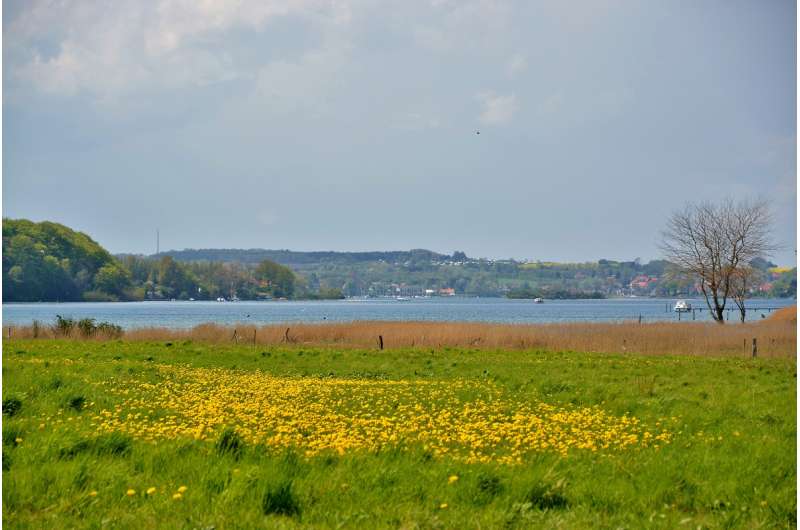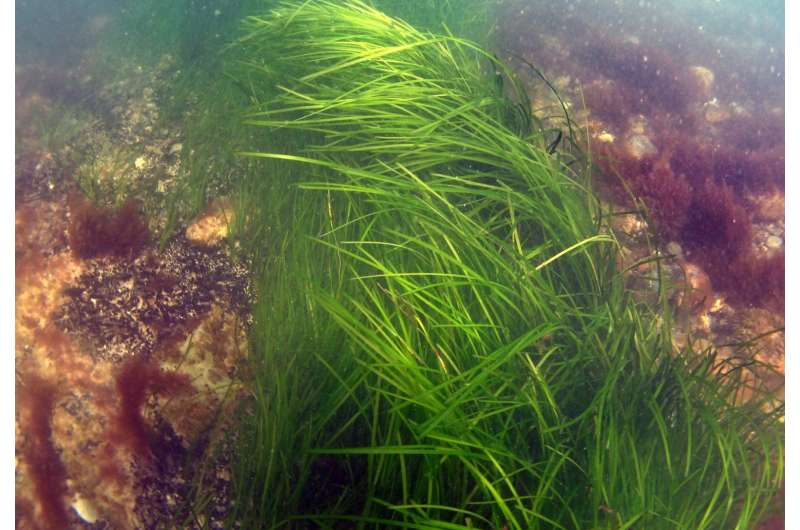Bay Thuroebund in South Funen Archipelago, Denmark. Credit: colorbox
Forests are potent carbon sinks, but oceanic seagrasses also store enormous amounts of carbon. And researchers report that a little bay in Denmark stores a record amount of carbon.
Seagrass plays a bigger role in the Earth's carbon cycle than most people think. Underwater meadows of seagrass are capable of storing large amounts of carbon—an attribute drawing considerable research attention as policy makers and scientists seek ways to reduce atmospheric CO2.
Efficient meadows of carbon-storing seagrass are found in coastal areas in many parts of the world. But according to biologists, one particular meadow in Denmark is by far the most efficient. The meadow is situated in a bay called Thurøbund on the island Thurø in the South Funen Archipelago, Denmark.
Special conditions in Thurøbund
"Many seagrass meadows around the world have been investigated. Recently, I was part of a study investigating and measuring carbon storing capabilities of 10 seagrass meadows in the Baltic Sea. No place comes even close to Thurøbund," says Professor Marianne Holmer, University of Southern Denmark (SDU). Holmer is head of SDU's Department of Biology and she is an expert in seagrass ecology and biogeochemistry.
The explanation is found in the special conditions in Thurøbund. "It is a very protected bay—and also very productive. So the seagrass thrives and when the plants die, they remain in the meadow. They are buried in the sediment, and in this process, their carbon content gets stored with them. In Finland, the seagrass grows in open coast areas, which means that the dead plants are much more often washed out to sea, taking the carbon with them. Once the carbon has been taken out to the sea, it is unclear what happens to it," Professor Holmer says.
Thurøbund stores ca. 27,000 grams of carbon (gC) pr. square meter. This figure has never been measured to be more than 10,000-11,000 gC pr. m2 in other parts of the world. According to the new study, Danish seagrass meadows store three to four times more carbon than Finnish meadows.
Harsher environment in Finland
The study has been published in Biogeosciences. The lead author is Ph.D. student Emilia Röhr of the University of Southern Denmark and Åbo Akademi University in Finland. Co-authors are Marianne Holmer and Christoffer Boström from Åbo Akademi University.
Eelgrass growing in Denmark. Credit: SDU
"The Finnish meadows in our study are more exposed than the Danish and they grow in harsher environments where the dead plants do not sink to the bottom, so their carbon content does not get stored in the sediment," says Röhr. It is not known what happens to the dead seagrass plants once they're washed out to the open sea. It's possible that their carbon content is stored elsewhere, or is ultimately released into the atmosphere as CO2.
Economic value
Due to the carbon storing efficiency of seagrass meadows, a system has been designed to calculate the economic value of their stored carbon. "The value in Denmark is 1809 Euro pr. hectar while in Finland it is 281 Euro," says Röhr. Other scientists have calculated that the global loss of seagrass equals 1.9 - 13.7 billion US dollars in lost carbon storing.
Many countries have a focus on restoring lost seagrass meadows. The meadows are not only good at storing carbon; they are also home to many small and large animals, including commercially important species such as shrimps, cod and flatfish. The plants also function as particle filters, keeping the water clear. On a global scale, Earth has lost estimated 29 percent of its seagrass meadows since 1879. Denmark has lost 80 to 90 percent since the 1930s.
Blue carbon
The worlds' oceans store vast amounts of carbon, especially in coastal areas like mangrove forests, seagrass meadows and salt marshes. This is called blue carbon, and the mechanisms are quite similar to those of land forests. Seagrass meadows cover only 0.1 - 0.2 percent of the worlds' seafloor, but they account for 18 percent of all ocean-stored carbon. The meadows in the Baltic Sea store 1.7 to 12 percent of all seagrass-meadow-stored carbon in the world.
Seagrass is a plant
Seagrass is not a seaweed, but a plant with flowers, leaves and roots. It also produces seeds, which are spread on the seafloor and grow into new plants. There are about 60 seagrass species around the world. In Denmark, eelgrass (Zostera marina) is the most common. Seagrass needs light and only grows in shallow water.
Journal information: Biogeosciences
Provided by University of Southern Denmark
























